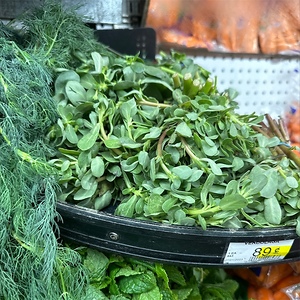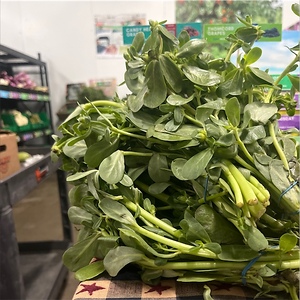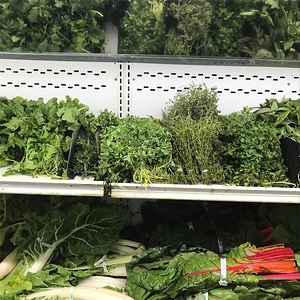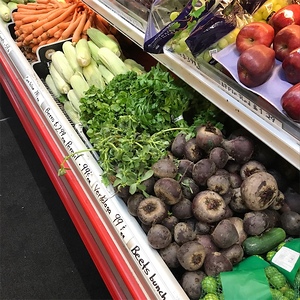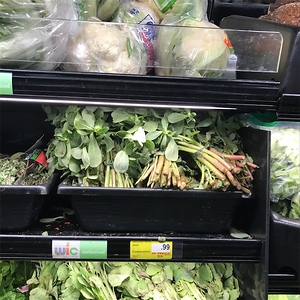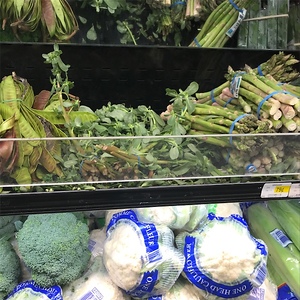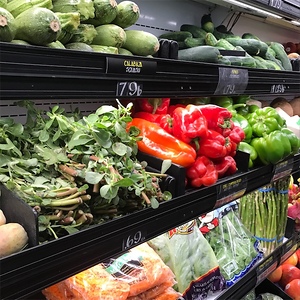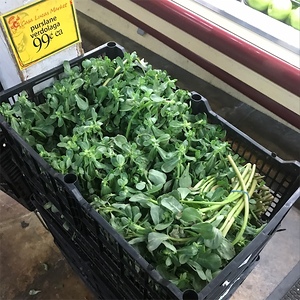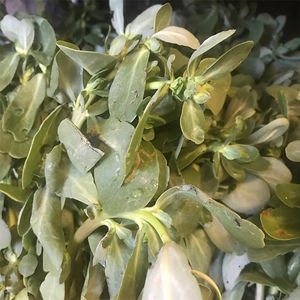

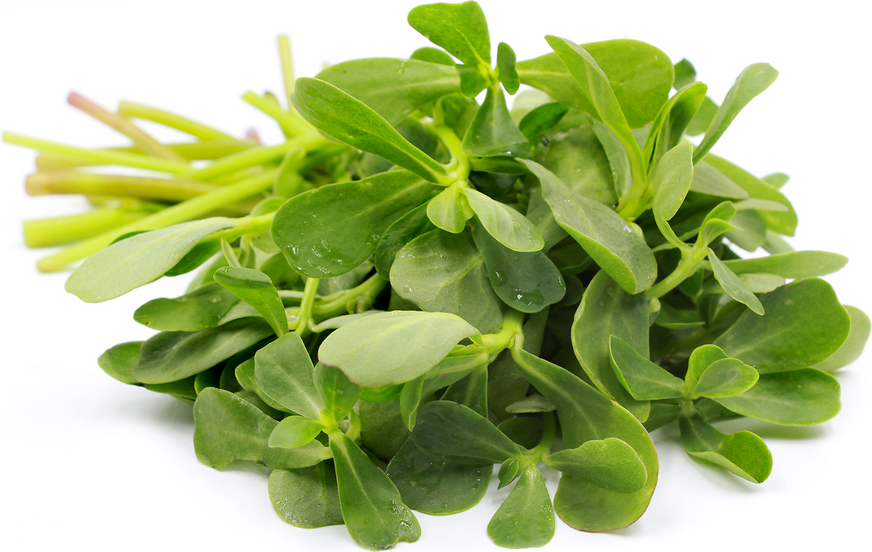
Verdolagas (Mexican Parsley)
Estimated Inventory, 12 ct : 1.67
This item was last sold on : 08/02/25
Description/Taste
Verdolaga is comprised of small leaves, averaging 2 to 5 centimeters in length, that are oval to tear-drop shaped, attached to thick, fleshy stems. The dark green leaves are flat, curved, and tapered and bear a smooth, waxy appearance with a crisp, succulent, and tender consistency. The stems are thick, aqueous, cylindrical, and dense, ranging in color from pale green to red-green. In the mid-summer, the plant also produces edible yellow flowers, which later give way to tiny black seeds. Each plant can produce a variable number of seeds, with some developing up to 240,000 seeds. Verdolaga contains edible stems, leaves, and flowers and has a refreshing, slightly salty, tangy, and acidic flavor with lemony, peppery, and sour nuances.
Seasons/Availability
Verdolaga is available year-round.
Current Facts
Verdolaga, botanically classified as Portulaca oleracea, is an annual, low-growing herb belonging to the Portulacaceae family. The crisp, succulent leaves grow on fleshy stems that can reach 30 to 40 centimeters in height, or depending on the variety, the plant may also have a trailing habit, spreading low across the ground like a vine. Verdolaga is a common plant that has been naturalized worldwide and is also known as Purslane, Pursley, Little Hogweed, Duckweed, and Pourpier. The herbaceous leaves and stems have been utilized in culinary and medicinal preparations for thousands of years, but over time, Verdolaga has also earned a reputation as an invasive weed. There are over forty varieties of Verdolaga, and each cultivar has a slightly different appearance and growth habit, depending on if it is a wild type or selectively bred variety for cultivation. Chefs favor Verdolaga for its bright and sour flavor, and the plant can be utilized in a variety of raw and cooked applications.
Nutritional Value
Verdolaga is an excellent source of vitamin A to maintain healthy organ functioning, vitamin E to guard the body against free radical damage, and vitamin C to reduce inflammation and strengthen the immune system. The herb is also a good source of calcium to protect bones and teeth, potassium to balance fluid levels within the body, and iron, manganese, and magnesium. In addition to vitamins and minerals, Verdolaga is a rich source of omega-3 fatty acids, including alpha-linolenic acid, which assists the body in promoting a healthy immune system and keeping organs, cells, and the circulatory system working correctly. In Traditional Chinese Medicine, the herb is used topically to soothe insect bites and stings, burns, and sores, or it is ingested to remove heat from the body, lessen sore throats, and cleanse the digestive tract.
Applications
Verdolaga has a tart and tangy, citrus-like flavor well suited for both fresh and lightly cooked preparations. The leaves and stems can be chopped and incorporated into smoothies, mixed into salsa, or tossed into salads. The crisp nature of the leaves is often used as a substitute for spinach in salads, and the herb’s naturally tangy flavor will complement sweet or herbaceous dressings. Verdolaga is also utilized as a topping over tacos, layered into sandwiches, or blended into sauces such as pesto or tzatziki. In addition to fresh preparations, Verdolaga can also be lightly cooked, but it should not be overcooked as the leaves develop a mucilaginous texture with heat. This vicious nature allows the leaves to thicken soups and stews, but prolonged cooking will cause the crisp texture to be lost. Verdolaga can be lightly steamed and mixed with buttered pasta, cooked and combined with potatoes, stirred into rice, or baked into casseroles. The succulent stems and leaves can also be stir-fried, cooked into omelets, or combined with several types of legumes for a pop of acidity and flavor. Verdolaga pairs well with cheeses such as feta, goat, and queso fresco, cucumber, avocado, arugula, tomatoes, tomatillos, potatoes, spices such as oregano, parsley, cumin, and ginger, chile peppers, walnuts, and fruits such as watermelon, strawberries, figs, pineapples, and pomegranates. Whole, unwashed leaves and stems will last for a few days when kept in a sealed container and stored in the refrigerator or placed in a glass of water and covered with a plastic bag. The leaves and stems can also be frozen or pickled for extended use.
Ethnic/Cultural Info
Verdolaga is the Spanish name for Purslane and is considered a quelite herb in Mexico. Quelite herbs are wild plants found throughout Mexico that have been used for centuries as edible and medicinal ingredients. The name quelite is derived from the Nahuatl word “quilitl,” meaning “edible plant,” signifying that the wild herbs have been present and widely use among Mexican indigenous populations since ancient times. In the present day, Verdolaga is harvested from wild plants and is also cultivated on a small scale for sale in local fresh markets throughout Mexico. Quelite herbs were once regarded as “poor man’s food,” but recently, chefs have rebranded the herbs as a traditional Mexican ingredient utilized in cutting-edge restaurants. Verdolaga is frequently served in stews, carnitas, and tamales, or it is boiled and mixed with cooked tomatoes and chile peppers as a simple but versatile side dish. One of the most well-known dishes that incorporates Verdolaga is espinazo de puerco con Verdolaga. The pork and Verdolaga-centric soup is filled with spices, chile peppers, and other aromatics and is often served with rice. This dish is popular in Central Mexico, and Verdolaga is added at the end of cooking to preserve the green’s crisp texture.
Geography/History
Verdolaga is believed by experts to be native to a wide range, spanning from the Indian subcontinent, the Middle East, to North Africa. The sprawling herb has grown wild since ancient times and has been naturalized worldwide in temperate and tropical climates. Verdolaga was introduced to Europe in the Early Ages and became a favored garden herb for culinary and medicinal use in the late 16th century. The herb was also brought to the New World in pre-Columbian times and has been found in lakes in Ontario, Canada, dating back to the 14th or 15th century. Verdolaga is a hardy herb, growing wild along roadsides, in sidewalk cracks, near crop fields, orchards, parks, home gardens, and lawns. Today Verdolaga is viewed as a culinary herb or invasive weed, depending on the region of the world it is growing in, and is found in Europe, Asia, Africa, Southeast Asia, Australia, and North America. In North America, Verdolaga has been documented in every state of the United States and along the Canadian and Mexico borders. For culinary purposes, the leaves and stems are harvested fresh and are sold in local markets or specialty distributors.
Featured Restaurants
Restaurants currently purchasing this product as an ingredient for their menu.
| Catania La Jolla | La Jolla CA | 619-884-5350 |
| Callie | San Diego CA | 619-947-9036 |
| WineSellar & Brasserie | San Diego CA | 858-450-9557 |
| Mabel's Gone Fishing | San Diego CA | 619-228-9851 |
| Artifact at Mingei | San Diego CA | 619-846-2164 |
| Wormwood | San Diego CA | 619-573-0289 |
| Trust Restaurant | San Diego CA | 609-780-7572 |
| Mission Pacific | Oceanside CA | 760-450-7864 |
| Tahona (Kitchen) | San Diego CA | 619-573-0289 |
Recipe Ideas
Recipes that include Verdolagas (Mexican Parsley). One



